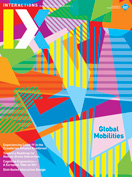Authors:
Alex Taylor, Daniela Rosner, Mikael Wiberg
The global ubiquity of technology is a striking feature of both the 21st century and late capitalism. Yet when, in the early 1990s, Mark Weiser famously imagined computing everywhere, embedded in the objects and surfaces that surround us, he paid little attention to what this vision of ubiquitous computing might look like at a global scale—how, in their ubiquity, technologies might be appropriated differently by people living in different global regions and with different beliefs and values. And how these same technologies, and the needs to service and maintain them, would impact lives and livelihoods in varied and often uneven ways. Yes, Weiser and, in parallel, many in HCI and UX design, came to recognize that technology should accommodate highly individual, human-centered needs. But as vital critical scholarship and activism remind us, seen through a prism defined by Western ideas of modernity, these fields generally give far less attention to how the Internet, mobile phones, social media, and so on entangle with wider systems of value and belief.
Consider the free flow of and easy access to information by which IX design is guided. Presumptions of freedom and access prefigure a world in which rights to technology are constrained only by economic wealth and mobility: Once people can afford the technology, freedom and access to information are thought of as a design problem. The uneven distribution of technology is not, though, just a matter of economic wealth and design.
With striking upheavals such as political unrest in the Middle East and Asia, a global pandemic, and the slow but growing mainstream awareness of the long history of racial injustices sanctioned under imperialist projects, many feeling the consequences of these problems have come to realize that the mobilities afforded by technology are enmeshed with social and cultural structures. We see, through a geopolitical optics, for example, that access to information operates as a mechanism of control. By cordoning off information sources, echo chambers amplify values, feed structural prejudice, and, at the extremes, incite violence. We also see the rise of new geopolitical and economic mobilities, such as digitally mediated mutual aid organizations that distribute food and other resources. How powerful figures exert authority over wealth and global resources, and fuel or curtail those mobilities, matters for our work in HCI and design. The economic successes of globalization and the ubiquity of the Internet and smartphones must be read as more than symbols of global flows that enable further innovation in information technology; they also become emblematic of contested routes of knowledge, wealth, and geopolitical power.
How powerful figures exert authority over wealth and global resources, and fuel or curtail those mobilities, matters for our work in HCI and design.
In this issue of Interactions, we have brought together works that speak to this much wider set of questions surrounding the global ubiquity of information technologies. Throughout the magazine, our dialogues, standpoints, and design-focused contributions include works engaging with themes of forced migration, Indigenous knowledges and making, and the challenges of conducting responsible research across borders.
A dialogue from Rachel Clarke and Cuthbert Tukendane, the standpoint from Reem Talhouk and Eiad Yafi, and Liam Healey's Exhibit X submission all present work focused on migration. Rachel and Cuthbert set the stage for research with Ugandan refugees under the shadow of the pandemic; from their research with refugees, asylum seekers, and other forcibly displaced populations in the Middle East, Reem and Eiad foreground the troubled legacy of empirical studies at sites of global migration and seek solidarity and reflexivity in future HCI research; and in Exhibit X, Liam presents a series of design interventions in the "Jungle Camp" of Northern France.
Indigenous ways of knowing and making are reflected in work located in Bangladesh by Abdullah Hasan Safir, Nusrat Jahan Mim, S. M. Taiabul Haque, and Syed Ishtiaque Ahmed; among Andean communities by Laura Cortés-Rico; and in the Ecuadorian Amazon rainforest by the Kaleidos Collective. Together, these contributions are a reminder that knowings and doings are always produced and seen by specific actors, and through particular places and times. There is no view from nowhere.
Almost all of these works, but in particular the dialogue between Anupriya Tuli and Margaret Jack, speak to questions of our own engagements with and participation in global movements. In their sensitively written text, Anu and Maggie show how the worldwide disruptions to mobilities precipitated by the pandemic have forced a pause and introspection, demanding questions about the entangled knots of technology, mobilities, and liberation.
Our regular content also engages with the global mobilities theme. In What Are You Reading, Angela Okune uses the work of Sylvia Wynter to consider how particular bodies and geographic regions are centered and, through the same cosmopolitical processes, others are placed at the periphery. In the After Veillance forum, Sareeta Amrute's conversation with Iván Chaar López about border controls and the increasing use of technology-mediated surveillance touches on similar themes of privilege and others inhabiting the periphery. Finally, in the Global Solidarity forum, Savita Bailur and Hélène Smertnik write of the liberatory potential afforded by digital financial services for women in Kenya and Côte d'Ivoire.
Altogether, we hope this issue will situate the digital technologies many of us design and study in a wider context of geopolitics, global economies, and diverse structures of value and belief. Through examples, we seek reminders of how technology's ubiquity has important and uneven consequences that we must be responsive to and responsible for.
Alex Taylor, Daniela Rosner, Mikael Wiberg [email protected]
Copyright held by authors
The Digital Library is published by the Association for Computing Machinery. Copyright © 2021 ACM, Inc.







Post Comment
No Comments Found